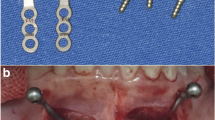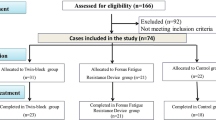Abstract
Objectives
To evaluate the effects of miniplate anchored Forsus Fatigue Resistant Device (MAF) and activator treatments in the pharyngeal airway dimensions and hyoid bone position.
Materials and methods
Thirty-eight patients with mandibular retrusion who were treated with either MAF or activator were selected retrospectively and compared with an untreated control group. The data of 114 lateral cephalograms, comprising those taken before treatment (T1) and at the end of functional treatment (T2), were evaluated with regard to their linear, angular, and area measurements.
Results
The mandibular length increased and the hyoid bone moved forward with both treatments (P < 0.05). The horizontal change in the hyoid bone position with MAF treatment was correlated with changes in the point B and ANB angle. Increases of 1.8 mm, 1.4 mm, and 1.8 mm in the pharyngeal airway dimensions were obtained at the levels of the second, third, and fourth cervical vertebra, respectively, with the MAF treatment. On the other hand, an increase of 1.9 mm was found at the level of the fourth cervical vertebra with the activator treatment. The greatest vertical movement in the Menton and the highest increase in the oropharyngeal area were observed in the MAF group (P < 0.05).
Conclusion
Both the MAF and activator treatments caused favorable maxillomandibular changes; however, the MAF treatment provided a greater increase in the oropharyngeal area according to both the increase in mandibular length and the change in the vertical position of the mandible.
Clinical relevance
Functional appliances were found to be useful in increasing the pharyngeal airway dimensions in the short-term. The skeletal anchored fixed functional appliance caused a greater increase in the oropharyngeal airway area that may be beneficial for Class II patients who carry a risk of having respiratory problems.



Similar content being viewed by others
References
Aksu M, Gorucu-Coskuner H, Taner T (2017) Assessment of upper airway size after orthopedic treatment for maxillary protrusion or mandibular retrusion. Am J Orthod Dentofac Orthop 152:364–370. https://doi.org/10.1016/j.ajodo.2016.12.027
Hourfar J, Kinzinger GSM, Meißner LK, Lisson JA (2017) Effects of two different removable functional appliances on depth of the posterior airway space.Effekte zweier verschiedener herausnehmbarer funktionskieferorthopädischer Apparaturen auf die Tiefe des extrathorakalen Luftraums. J Orofac Orthop / Fortschritte der Kieferorthopädie 78:166–175. https://doi.org/10.1007/s00056-016-0071-z
Gul Amuk N, Kurt G, Baysal A, Turker G (2019) Changes in pharyngeal airway dimensions following incremental and maximum bite advancement during Herbst-rapid palatal expander appliance therapy in late adolescent and young adult patients: a randomized non-controlled prospective clinical study. Eur J Orthod 41:322–330. https://doi.org/10.1093/ejo/cjz011
Godt A, Koos B, Hagen H, Göz G (2011) Changes in upper airway width associated with Class II treatments (headgear vs activator) and different growth patterns. Angle Orthod 81:440–446. https://doi.org/10.2319/090710-525.1
Ulusoy C, Canigur Bavbek N, Tuncer B et al (2014) Evaluation of airway dimensions and changes in hyoid bone position following class II functional therapy with activator. Acta Odontol Scand 72:917–925. https://doi.org/10.3109/00016357.2014.923109
Han S, Choi YJ, Chung CJ, Kim JY, Kim KH (2014) Long-term pharyngeal airway changes after bionator treatment in adolescents with skeletal Class II malocclusions. Korean J Orthod 44:13–19. https://doi.org/10.4041/kjod.2014.44.1.13
Drosen C, Bock NC, von Bremen J, Pancherz H, Ruf S (2018) Long-term effects of Class II Herbst treatment on the pharyngeal airway width. Eur J Orthod 40:82–89. https://doi.org/10.1093/ejo/cjx032
Saaresranta T, Polo O (2006) Sleep-disordered breathing and hormones. Neuroendocr Correl Sleep/Wakefulness 437–470. https://doi.org/10.1007/0-387-23692-9_23
Kaditis AG, Alvarez MLA, Boudewyns A et al (2016) Obstructive sleep disordered breathing in 2- to 18-year-old children: diagnosis and management. Eur Respir J 47:69–94. https://doi.org/10.1183/13993003.00385-2015
Celikoglu M, Buyuk SK, Ekizer A, Unal T (2016) Pharyngeal airway effects of Herbst and skeletal anchored Forsus FRD EZ appliances. Int J Pediatr Otorhinolaryngol 90:23–28. https://doi.org/10.1016/j.ijporl.2016.08.020
Lin YC, Lin HC, Tsai HH (2011) Changes in the pharyngeal airway and position of the hyoid bone after treatment with a modified bionator in growing patients with retrognathia. J Exp Clin Med 3:93–98. https://doi.org/10.1016/j.jecm.2011.02.005
Bavbek NC, Tuncer BB, Turkoz C, Ulusoy C, Tuncer C (2016) Changes in airway dimensions and hyoid bone position following class II correction with forsus fatigue resistant device. Clin Oral Investig 20:1747–1755. https://doi.org/10.1007/s00784-015-1659-1
Elkordy SA, Abouelezz AM, Fayed MMS, Aboulfotouh MH, Mostafa YA (2019) Evaluation of the miniplate-anchored Forsus Fatigue Resistant Device in skeletal Class II growing subjects: a randomized controlled trial. Angle Orthod 89:391–403. https://doi.org/10.2319/062018-468.1
Pandis N (2012) Sample calculations for comparison of 2 means. Am J Orthod Dentofac Orthop 141:519–521
Kannan A, Sathyanarayana HP, Padmanabhan S (2017) Effect of functional appliances on the airway dimensions in patients with skeletal class II malocclusion: a systematic review. J Orthod Sci 6:54–64. https://doi.org/10.4103/jos.JOS_154_16
Hänggi MP, Teuscher UM, Roos M, Peltomäki TA (2008) Long-term changes in pharyngeal airway dimensions following activator-headgear and fixed appliance treatment. Eur J Orthod 30:598–605. https://doi.org/10.1093/ejo/cjn055
Kinzinger G, Czapka K, Ludwig B, Glasl B, Gross U, Lisson J (2011) Effects of fixed appliances in correcting Angle Class II on the depth of the posterior airway space: FMA vs. Herbst appliance--a retrospective cephalometric study. J Orofac Orthop 72:301–320. https://doi.org/10.1007/s00056-011-0035-2
Joseph AA, Elbaum J, Cisneros GJ, Eisig SB (1998) A cephalometric comparative study of the soft tissue airway dimensions in persons with hyperdivergent and normodivergent facial patterns. J Oral Maxillofac Surg Off J Am Assoc Oral Maxillofac Surg 56:135–140. https://doi.org/10.1016/s0278-2391(98)90850-3
Jena AK, Singh SP, Utreja AK (2010) Sagittal mandibular development effects on the dimensions of the awake pharyngeal airway passage. Angle Orthod 80:1061–1067. https://doi.org/10.2319/030210-125.1
Turkkahraman H, Eliacik SK, Findik Y (2016) Effects of miniplate anchored and conventional Forsus Fatigue Resistant Devices in the treatment of Class II malocclusion. Angle Orthod 86:1026–1032. https://doi.org/10.2319/122515-887.1
Rizk S, Kulbersh VP, Al-Qawasmi R (2016) Changes in the oropharyngeal airway of Class II patients treated with the mandibular anterior repositioning appliance. Angle Orthod 86:955–961. https://doi.org/10.2319/042915-295.1
Zhou L, Zhao Z, Lu D (2000) The analysis of the changes of tongue shape and position, hyoid position in Class II, division 1 malocclusion treated with functional appliances (FR-I). West China J Stomatol 18:123–125
Chung DH, Hatch JP, Dolce C, van Sickels JE, Bays RA, Rugh JD (2001) Positional change of the hyoid bone after bilateral sagittal split osteotomy with rigid and wire fixation. Am J Orthod Dentofac Orthop 119:382–389. https://doi.org/10.1067/mod.2001.112670
Tsuiki S, Hiyama S, Ono T, Imamura N, Ishiwata Y, Kuroda T, Lowe AA (2001) Effects of a titratable oral appliance on supine airway size in awake non-apneic individuals. Sleep 24:554–560. https://doi.org/10.1093/sleep/24.5.554
Eggensperger N, Smolka K, Johner A, Rahal A, Thüer U, Iizuka T (2005) Long-term changes of hyoid bone and pharyngeal airway size following advancement of the mandible. Oral Surg Oral Med Oral Pathol Oral Radiol Endod 99:404–410. https://doi.org/10.1016/j.tripleo.2004.07.019
Bronoosh P, Khojastepour L (2015) Analysis of pharyngeal airway using lateral cephalogram vs CBCT images: a cross-sectional retrospective study. Open Dent J 9:263–266. https://doi.org/10.2174/1874210601509010263
Vizzotto MB, Liedke GS, Delamare EL, Silveira HD, Dutra V, Silveira HE (2012) A comparative study of lateral cephalograms and cone-beam computed tomographic images in upper airway assessment. Eur J Orthod 34:390–393. https://doi.org/10.1093/ejo/cjr012
Aras I, Pasaoglu A, Olmez S, Unal I, Aras A (2016) Upper airway changes following single-step or stepwise advancement using the Functional Mandibular Advancer. J Orofac Orthop 77:454–462. https://doi.org/10.1007/s00056-016-0062-0
Colceriu-Șimon IM, Băciuț M, Ştiufiuc RI et al (2019) Clinical indications and radiation doses of cone beam computed tomography in orthodontics. Med Pharm Rep 92:346–351. https://doi.org/10.15386/mpr-1434
Acknowledgments
The authors would like to thank the American Association of Orthodontists Foundation for their kindness in the donation of growth study records.
Author information
Authors and Affiliations
Contributions
All the authors have read and approved the manuscript statement.
Corresponding author
Ethics declarations
Conflict of interest
The authors declare that they have no conflict of interest.
Ethical approval
This study was approved by the Baskent University Institutional Review Board and Ethics Committee (Project number: D-KA 19/14). All procedures performed in studies involving human participants were in accordance with the ethical standards of the institutional and/or national research committee and with the 1964 Helsinki declaration and its later amendments or comparable ethical standards.
Informed consent
Informed consent was obtained from all individual participants included in the study.
Additional information
Publisher’s note
Springer Nature remains neutral with regard to jurisdictional claims in published maps and institutional affiliations.
Rights and permissions
About this article
Cite this article
İnce-Bingöl, S., Kaya, B. Pharyngeal airway and hyoid bone position changes of skeletal anchored Forsus Fatigue Resistant Device and activator appliances. Clin Oral Invest 25, 4841–4850 (2021). https://doi.org/10.1007/s00784-021-03789-9
Received:
Accepted:
Published:
Issue Date:
DOI: https://doi.org/10.1007/s00784-021-03789-9




